
A tire or tyre is a ring-shaped component that surrounds a wheel's rim to transfer a vehicle's load from the axle through the wheel to the ground and to provide traction on the surface over which the wheel travels. Most tires, such as those for automobiles and bicycles, are pneumatically inflated structures, which also provide a flexible cushion that absorbs shock as the tire rolls over rough features on the surface. Tires provide a footprint, called a contact patch, that is designed to match the weight of the vehicle with the bearing strength of the surface that it rolls over by providing a bearing pressure that will not deform the surface excessively.

An inflatable is an object that can be inflated with a gas, usually with air, but hydrogen, helium, and nitrogen are also used. One of several advantages of an inflatable is that it can be stored in a small space when not inflated, since inflatables depend on the presence of a gas to maintain their size and shape. Function fulfillment per mass used compared with non-inflatable strategies is a key advantage. Stadium cushions, impact guards, vehicle wheel inner tubes, emergency air bags, and inflatable space habitats employ the inflatable principle. Inflation occurs through several strategies: pumps, ram-air, blowing, and suction.

Landing gear is the undercarriage of an aircraft or spacecraft that is used for takeoff or landing. For aircraft it is generally needed for both. It was also formerly called alighting gear by some manufacturers, such as the Glenn L. Martin Company. For aircraft, Stinton makes the terminology distinction undercarriage (British) = landing gear (US).

On 25 July 2000, Air France Flight 4590, a Concorde passenger jet on an international charter flight from Paris to New York, crashed shortly after takeoff, killing all 109 people on board and four on the ground. It was the only fatal Concorde accident during its 27-year operational history.
An inerting system decreases the probability of combustion of flammable materials stored in a confined space. The most common such system is a fuel tank containing a combustible liquid, such as gasoline, diesel fuel, aviation fuel, jet fuel, or rocket propellant. After being fully filled, and during use, there is a space above the fuel, called the ullage, that contains evaporated fuel mixed with air, which contains the oxygen necessary for combustion. Under the right conditions this mixture can ignite. An inerting system replaces the air with a gas that cannot support combustion, such as nitrogen.

Aquaplaning or hydroplaning by the tires of a road vehicle, aircraft or other wheeled vehicle occurs when a layer of water builds between the wheels of the vehicle and the road surface, leading to a loss of traction that prevents the vehicle from responding to control inputs. If it occurs to all wheels simultaneously, the vehicle becomes, in effect, an uncontrolled sled. Aquaplaning is a different phenomenon from when water on the surface of the roadway merely acts as a lubricant. Traction is diminished on wet pavement even when aquaplaning is not occurring.

Gas blending for scuba diving is the filling of diving cylinders with non-air breathing gases such as nitrox, trimix and heliox. Use of these gases is generally intended to improve overall safety of the planned dive, by reducing the risk of decompression sickness and/or nitrogen narcosis, and may improve ease of breathing.
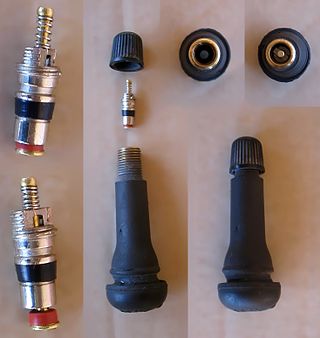
The Schrader valve is a type of pneumatic tire valve used on virtually every motor vehicle in the world today. The Schrader company, for which it was named, was founded in 1844 by August Schrader. The original Schrader valve design was invented in 1891, and patented in the United States in 1893.
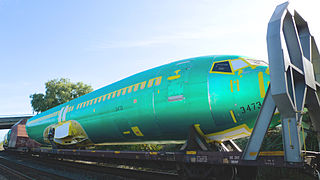
Cabin pressurization is a process in which conditioned air is pumped into the cabin of an aircraft or spacecraft in order to create a safe and comfortable environment for humans flying at high altitudes. For aircraft, this air is usually bled off from the gas turbine engines at the compressor stage, and for spacecraft, it is carried in high-pressure, often cryogenic, tanks. The air is cooled, humidified, and mixed with recirculated air by one or more environmental control systems before it is distributed to the cabin.
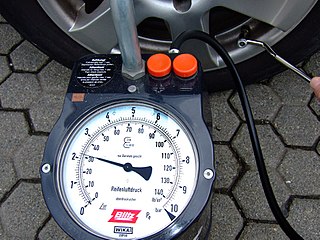
Cold inflation pressure is the inflation pressure of tires before a car is driven and the tires (tyres) warmed up. Recommended cold inflation pressure is displayed on the owner's manual and on the placard attached to the vehicle door edge, pillar, glovebox door or fuel filler flap. Most passenger cars are recommended to have a tire pressure of 2.1 to 2.4 bars when not warmed by driving. A 2001 NHTSA study found that 40% of passenger cars have at least one tire under-inflated by 0.4 bars (6 psi) or more. Drivers are encouraged to make sure their tires are adequately inflated, as under inflated tires can greatly reduce fuel economy, increase emissions, cause increased wear on the edges of the tread surface, and can lead to overheating and premature failure of the tire. Excessive pressure, on the other hand, will lead to impact-breaks, decreased braking performance, and cause increased wear on the center part of the tread surface.
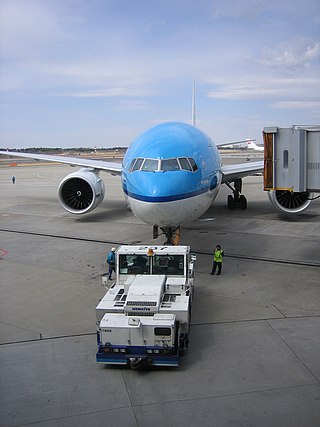
In aviation, pushback is an airport procedure during which an aircraft is pushed backwards away from its parking position, usually at an airport gate by external power. Pushbacks are carried out by special, low-profile vehicles called pushback tractors or tugs.

Pneumatic tires are manufactured according to relatively standardized processes and machinery, in around 455 tire factories in the world. With over 1 billion tires manufactured worldwide annually, the tire industry is a major consumer of natural rubber. Tire factories start with bulk raw materials such as synthetic rubber, carbon black, and chemicals and produce numerous specialized components that are assembled and cured.
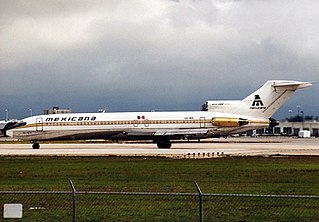
Mexicana de Aviación Flight 940, operated by Mexicana de Aviación, was a scheduled international flight from Mexico City to Los Angeles with stopovers in Puerto Vallarta and Mazatlán on March 31, 1986, utilizing a Boeing 727-200 registered as XA-MEM, when the plane crashed into El Carbón, a mountain in the Sierra Madre Occidental mountain range northwest of Mexico City, killing everyone on board. With 167 deaths, the crash of Flight 940 is the deadliest aviation disaster ever to occur on Mexican soil, and the deadliest involving a Boeing 727.

An evacuation slide is an inflatable slide used to evacuate an aircraft quickly. An escape slide is required on all commercial aircraft where the door sill height is such that, in the event of an evacuation, passengers would be unable to step down from the door uninjured.
A tubeless tire is a pneumatic tire that does not require a separate inner tube.

A bicycle tire is a tire that fits on the wheel of a bicycle or similar vehicle. These tires may also be used on tricycles, wheelchairs, and handcycles, frequently for racing. Bicycle tires provide an important source of suspension, generate the lateral forces necessary for balancing and turning, and generate the longitudinal forces necessary for propulsion and braking. Although the use of a pneumatic tire greatly reduces rolling resistance compared to the use of a rigid wheel or solid tire, the tires are still typically the second largest source, after wind resistance, of power consumption on a level road. The modern detachable pneumatic bicycle tire contributed to the popularity and eventual dominance of the safety bicycle.

Nitrogen generators and stations are stationary or mobile air-to-nitrogen production complexes.

The Modular Equipment Transporter (MET) was a two-wheeled, hand-pulled vehicle that was used as an equipment hauling device on traverses across the lunar surface. Designed after Apollo 12 astronauts Pete Conrad and Alan Bean had difficulties lugging their equipment significant distances to and from their Lunar Module, the MET primarily functioned as a portable workbench with a place for hand tools and their carrier, cameras, spare camera magazines, rock sample bags, environmental sample containers, and the portable magnetometer with its sensor and tripod. It was carried on the 1971 Apollo 14 mission and was planned to be used on Apollo 15, but was used only on Apollo 14 since Apollo 15's mission was changed to be the first to employ the motorized Lunar Roving Vehicle, which transported both astronauts and equipment.

The following outline is provided as an overview of and topical guide to tires:
Dunlop Aircraft Tyres is a tyre-manufacturing company in Birmingham, England, that claims to be world's only specialist aircraft tyre manufacturer and retreader, for aircraft landing gear.


















